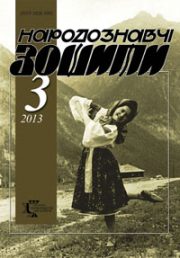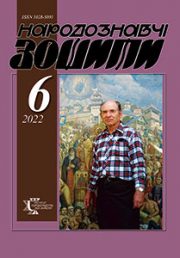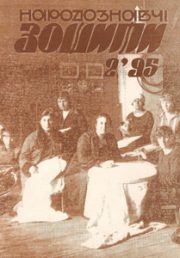The Ethnology Notebooks. 2020. № 5 (155), 1169—1174
UDK 7.038.6-025.12:005.591.61
DOI https://doi.org/10.15407/nz2020.05.1169
ARTISTIC EXPERIMENT OF POSTMODERN ART PRACTICES
CHYRVA Anna
- ORCID ID: http://orcid.org/0000-0002-0326-5296
- PhD candidate,
- Kharkiv state academy of design andarts,
- 8, street of Arts, 61002, Kharkiv, Ukraine
- Contacts: e-mail: dasein.anna@gmail.com
Abstract. The purpose of the paper. To consider artistic experiment as a basic mechanism of art and design practices, to analyze its varieties within the artistic-design creative work of postmodernism and to classify them based on the characteristics of artistic image.
Research methods: generalization, systematization and comparison that allow considering an artistic experiment within contemporary art and design practices.
The result of the study is identification of the characteristics of artistic experiment and the definition of the main principles of its application and conduct, analysis of existing typologies of experimental activities in the field of contemporaryvisual art and design. Based on the generalizations made, the classification of artistic experiment within the artistic and design approaches of postmodernism has been presented.
Conclusions. Artistic experiment is a leading tool of contemporary art, design, scientific and technological practices. In addition to creating the actual artistic value, it influences the development of related industries. With constant differentiation of contemporary art, branching, complication and a certain diffusion of art and techno-scientific practices in the artistic and design approaches of postmodernism, the nature, structure and methods of artistic experiment have changed. The proposed classification of artistic experiment based on the characteristics of its result — artistic and design image, made it possible to reduce many artistic design experimental practices to two: mythopoetic and techno-scientific. Identified mythopoetic and techno-scientific types of artistic experiment correspond to the cultural-linguistic and techno-scientific lines of postmodern art development.
Keywords: artistic experiment, artistic and design activity, postmodernism.
Received 7.08.2020
REFERENCES
- Galkin, D.V. (2011). Artificial Life: Science and Computer Technology in Contemporary Art. Vestnik Tomskogo gosudarstvennogo universiteta. Kul’turologija i iskusstvovedenie (Pp. 74—79). Retrieved from: https://cyberleninka.ru/article/n/iskusstvennaya-zhizn-nauka-i-kompyuternye-tehnologii-v-sovremennom-iskusstve. (Accessed 28 June 2020) [in Russian].
- Galkin, D.V. (2013). From machine inspiration to artificial life: stages in the development of technological art. Vestnik Tomskogo gosudarstvennogo universiteta. Kul’turologija i iskusstvovedenie (Pp. 44—51). (Accessed 28 June 2020) [in Russian].
- Medvedev, A.V. (2012). Art as a from of social experiment. Chelovek v mire kul’tury (Pp. 45—49). Retrieved from: https://cyberleninka.ru/article/n/iskusstvo-kak-forma-sotsialnogo-eksperimenta. (Accessed 28 June 2020) [in Russian].
- Beniuk, O.B. (2018). Artistic experiment in aesthetic discourse. Visnyk Natsional’noi akademii kerivnykh kadriv kul’tury i mystetstv. Kyiv, no. 3, pp. 252—256.
- Stor, I.N. (2003). Meaning formation in graphic design. Metamorphoses of visual images. Moskva: MGTU im. A.N. Kosygina [in Russian].
- Erohin, S.V. (2011). Theory and practice of scientific art. Moskva: PTF-MIJeJe [in Russian].
- Fljusser, V. (2008). For the philosophy of photography. per. s nem. G. Hajdarovoj. Sankt-Peterburg: Izdatel’stvo S.-Peterburgskogo universiteta.
- Bulatov, D. (2013). Technobiological work of art. DI, 2, 78—92 [in Russian].
- Yur, M. (2014). Artistic experiment as a creative strategy of Ukrainian artists. Suchasne mystetstvo, 10, 243—248 [in Ukrainian].







